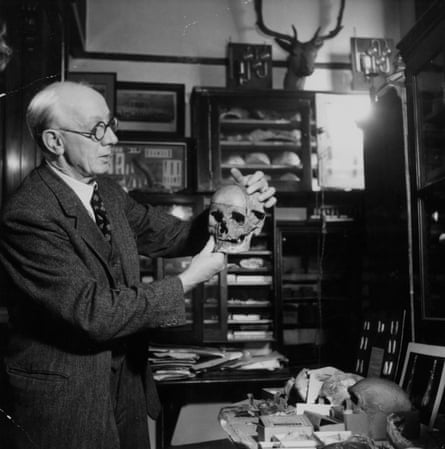Opinion Piece: A Revealed Jaw
The skull unearthed in Sussex at Piltdown 40 years ago, once considered a significant artifact of early humans, has lost some of its significance. However, it still draws attention from both scientists and the general public who are curious about their ancestry. After thorough investigation, three scientists have declared that the jaw and eyetooth of the skull were intentionally falsified. This is the latest blow to the once highly esteemed Piltdown Man. Previous discoveries and advancements in methods have already diminished its importance. Recent developments have allowed for a rough estimation of the age of fossil skulls, revealing that the Piltdown skull is not as old as other finds, such as the one at Swanscombe. The discoverer of the Swanscombe skull, Mr AT Marston, consistently argued that the Piltdown skull and jaw did not belong to the same individual. Despite criticism, he has now been proven correct, with the Swanscombe skull taking the rightful place that was previously held by Piltdown Man. However, this revelation may not greatly impact the overall understanding of human evolution, as many paleontologists have always viewed the Piltdown find as an unusual anomaly.
The report detailing the investigation by Dr Weiner, Dr Oakley, and Professor Le Gros Clark that revealed the true identity of Piltdown Man’s jaw and tooth reads like a clever detective story. However, it is unable to determine the identity of the highly skilled and unscrupulous hoaxer responsible for the deception – a mystery that will likely remain unsolved after 40 years. The Piltdown Hoaxer is a prime example of a successful forgery in the field of anthropology. Unlike other infamous hoaxers, such as Thomas Wise and Van Meegeren who were exposed during their lifetimes, it is likely that this one passed away without ever having to face the consequences of their actions.
The characteristics of the Piltdown skull that suggest it was deliberately faked include the lower jaw resembling that of a chimpanzee.
Advancements in fluorine analysis have enabled researchers to conduct tests that resulted in three scientists determining the mandible and canine tooth of the “Piltdown skull” were intentionally fabricated. The findings of the three investigators – Dr JS Weiner, Dr KP Oakley, and Professor WE Le Gros Clark – have been published in the Bulletin of the British Museum (Natural History).
In 1949, experiments with Fluorine were conducted according to the report. However, they were unable to reconcile the conflicting evidence of a skull that resembled that of Homo Sapiens, but a jaw and canine tooth that were similar to those of a primate. It wasn’t until Dr Weiner presented the idea that the jaw and tooth could have been intentionally fabricated to mimic fossils from modern apes like chimpanzees or orangutans, that the researchers were able to make progress in their investigation.
The experiments provided proof that the unusual wear on the teeth could have been caused by intentionally wearing down chimpanzee teeth.
“No Doubt”
Additional and more complex examinations of fluorine indicated that the Piltdown cranium is likely from the Upper Pleistocene era. However, the mandible, canine tooth, and isolated molar appear to be much more recent. This was supported by an analysis of the nitrogen levels in these fossils compared to modern bone and teeth. Additional tests revealed that the outer layer on the mandible and teeth did not match that of the cranium. The supposed iron coating on the canine tooth was actually a durable and flexible paint-like substance, rather than ferruginous as originally believed by the initial discoverers.

While the cranial pieces are heavily dyed with iron (up to 8% throughout), the iron staining on the mandible is only on the surface. A sample taken in 1949 showed 7% iron, but upon further drilling during our re-examination, the sample was lighter in color and only contained 2-3% iron.
The initial sections of the skull were found, but subsequent ones were not, and were accidentally exposed to a bichromate of potash solution. According to the report, it was not anticipated that the jawbone (which was unearthed later) would also be discolored by the chromate.
The jaw does contain chromate, as shown by iron and chromate staining. This leads us to believe that the Piltdown jaw was deliberately altered to match a modern ape’s jaw with the mineralized cranial fragments. After further investigation, it is now clear that the respected paleontologists and archaeologists involved in the Piltdown excavations were deceived by a highly elaborate and carefully planned hoax. However, it should be noted that those who originally assumed the Piltdown fragments belonged to one individual or identified the mandible and canine as those of a fossil ape were not at fault, as the faking of these bones was incredibly skilled and the perpetration of the hoax was unscrupulous and inexplicable. This event has no parallel in the history of paleontological discovery.
Finally, it should be noted that removing the Piltdown jaw and teeth from further discussion significantly clarifies the issue of human evolution. This is because the Piltdown Man (Eoanthropus) was a problematic and puzzling component in the fossil record of the Hominidae. It did not conform to the expected mixture of physical features and chronological order, as seen in other evidence of human evolution found in different regions of the world.
Additionally, the issue of contested bones has been a longstanding dispute.
Source: theguardian.com



